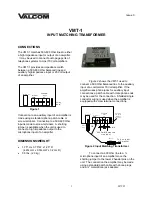
✔
What is the PBT control?
The PBT function electronically modifies the IF passband
width to reject interference. This transceiver uses the
DSP circuit for the PBT function.
$1
NOTCH SWITCH [NOTCH]
(p. 61)
(Mode = Auto notch : SSB/AM/FM
Manual notch : SSB/CW/RTTY/AM)
➥
In the SSB and AM modes, push to toggle the
notch function between auto, manual and OFF.
• Either the Auto or Manual Notch function can be
turned OFF in the “[NOTCH] SW” item of the Set
mode. (p. 88)
➥
In
the
FM mode, push to turn the Auto Notch
function ON or OFF.
➥
In
the
CW or RTTY mode, push to turn the Man-
ual Notch function ON or OFF.
• “MNF” appears when the Manual Notch function is
ON.
• “ANF” appears when the Auto Notch function is ON.
• No icon appears when the Notch function is OFF.
➥
Hold down for 1 second to switch the manual
filter characteristics from wide, mid and narrow
when the Manual Notch function is selected.
✔
What is the notch filter?
The notch filter is a narrow filter that eliminates unwanted
CW or AM carrier tones, while preserving the desired
voice signal. The DSP circuit automatically adjusts the
notch frequency to effectively eliminate unwanted tones.
$2
MANUAL NOTCH FILTER CONTROL [NOTCH]
(inner control; p. 61)
Rotate to adjust the notch frequency to reject an inter-
fering signal when the Manual Notch function is ON.
• Notch filter center frequency:
SSB/RTTY
: –1040 Hz to +4040 Hz
CW
: CW pitch freq. –2540 Hz to
CW pitch freq. +2540 Hz
AM
: –5060 Hz to +5100 Hz
$3
CW PITCH CONTROL [CW PITCH]
(outer control; p. 37)
Rotate to shift the received CW audio pitch and the
CW sidetone pitch without changing the operating
frequency.
• The pitch can be adjusted from 300 to 900 Hz in ap
-
proximately 5 Hz steps.
$4
∂
TX SWITCH [
∂
TX]
(p. 65)
➥
Push to turn the
∂
TX function ON or OFF.
• Use the [RIT/
∂
TX] control to vary the
∂
TX frequency.
➥
Hold down for 1 second to shift the transmit fre-
quency up or down by the
∂
TX frequency shift.
✔
What is the
∂
TX function?
∂
TX shifts the transmit frequency without shifting the re-
ceive frequency. This is useful for simple split frequency
operation in CW, etc.
$5
CLEAR SWITCH [CLEAR]
(pp. 53, 65)
Hold down for 1 second* to clear the RIT/
∂
TX fre-
quency shift.
* When the “Quick RIT Clear” item in the Set mode is set
to “ON,” push
momentarily to reset the frequency shift.
(p. 88)
$6
RIT SWITCH [RIT]
(p. 53)
➥
Push to turn the RIT function ON or OFF.
• Use [RIT/
∂
TX] control to vary the RIT frequency.
➥
Hold down for 1 second to shift the receive fre-
quency up or down by the
RIT
frequency shift.
✔
What is the RIT function?
The RIT (Receiver Incremental Tuning) shifts the receive
frequency without shifting the transmit frequency.
This is useful for fine tuning stations calling you off-fre-
quency or when you prefer to listen to slightly different-
sounding voice characteristics, etc.
$7
RIT/
∂
TX CONTROL [RIT/
∂
TX]
(pp. 53, 65)
When either or both the RIT/
∂
TX functions are ON,
rotate to adjust the RIT/
∂
TX frequency shift.
• Rotate the control clockwise to increase the frequency,
or counterclockwise to decrease the frequency.
• The frequency shift range is ±9.999 kHz in 10 Hz steps.
The control tunes in 1 Hz steps when the operating fre-
quency readout is set to the 1 Hz step readout.
Shift high
Shift low
6
1
PANEL DESCRIPTION
1
2
3
4
5
6
7
8
9
10
11
12
13
14
15
16
17
18
19
20
21
Higher pitch
Lower pitch
Higher frequency
Lower frequency
PBT2
PBT1
–
+
Low cut
High cut
Center
Содержание IC-i7410
Страница 1: ...INSTRUCTION MANUAL HF 50 MHz TRANSCEIVER i7410...
Страница 122: ...MEMO...
Страница 123: ...MEMO 1 2 3 4 5 6 7 8 9 10 11 12 13 14 15 16 17 18 19 20 21...














































